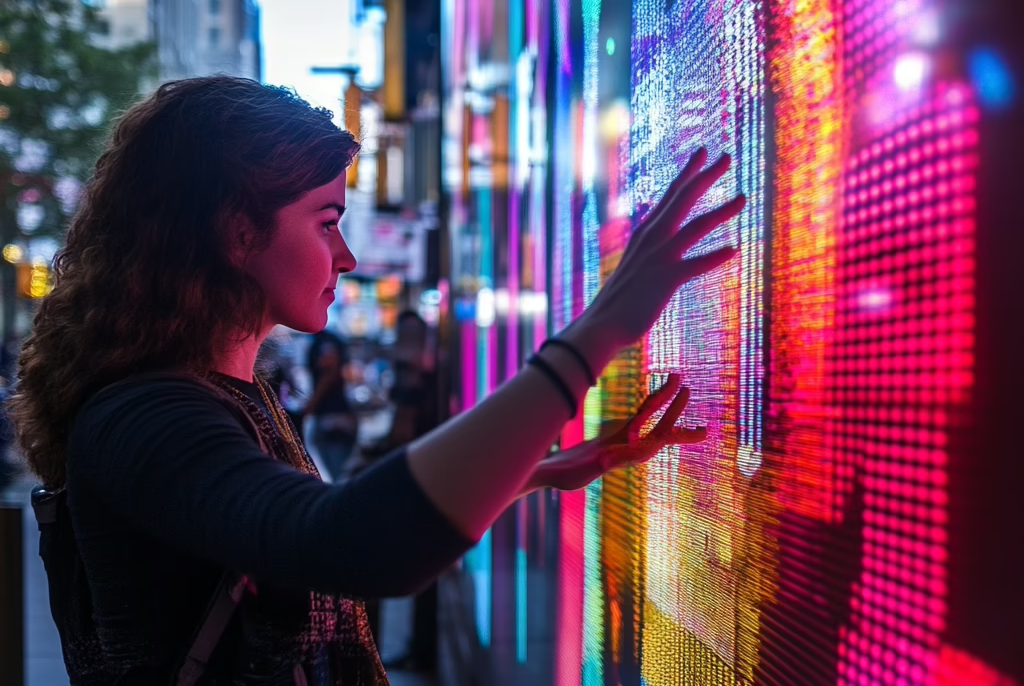In a world dominated by fast-evolving technology and an insatiable demand for captivating experiences, customer engagement has taken center stage. Static advertising and passive screens are no longer enough to captivate modern audiences. Enter interactive LED displays — a groundbreaking innovation that’s transforming the landscape of marketing, retail, education, and entertainment.
In this blog post, we’ll explore why interactive LED displays represent the next frontier in customer engagement, their benefits, real-world applications, and key considerations for integrating them into your business strategy.
What Are Interactive LED Displays?
Interactive LED displays are advanced digital screens that respond to user input through touch, gestures, proximity, motion sensing, or mobile integration. Unlike traditional displays that simply present information, interactive LEDs create two-way communication between brands and their audiences.
Common Interaction Methods:
- Touchscreen capabilities
- Motion tracking sensors
- QR code and mobile device integration
- Gesture recognition
- Augmented reality overlays
By transforming viewers into participants, these displays create memorable and personalized experiences that foster deeper brand loyalty and engagement.
Why Interactive LED Displays Matter in 2025
1. Elevating Customer Expectations
Today’s consumers crave immersive and personalized experiences. An interactive LED display invites audiences to engage on their own terms, making them feel valued and involved.
2. Standing Out in a Crowded Market
With advertising noise at an all-time high, brands must innovate to cut through the clutter. Interactive LED walls offer a dynamic way to grab attention and leave lasting impressions.
3. Data Collection and Insights
These displays can capture valuable data about user interactions, preferences, and behaviors, offering businesses deep insights to refine future marketing and customer service strategies.
4. Boosting Conversion Rates
Interactive experiences drive engagement time, brand recall, and emotional connections—critical factors that translate into higher conversion rates.
Key Benefits of Interactive LED Displays
1. Immersive Storytelling
Interactive displays allow brands to create compelling narratives that customers can explore at their own pace.
2. Personalization
Brands can offer customized content experiences based on user input, enhancing relevance and emotional connection.
3. Increased Engagement Time
Interactive elements encourage visitors to spend more time at the display, increasing the opportunity to convey brand messages.
4. Social Sharing Potential
Unique and fun interactive experiences are highly shareable on social media, expanding brand visibility organically.
5. Competitive Differentiation
Businesses that adopt interactive LED technology early establish themselves as innovative leaders in their industries.
Real-World Applications of Interactive LED Displays
1. Retail
- Virtual try-on stations for fashion and accessories
- Interactive store maps and product locators
- Personalized product recommendations based on preferences
2. Events and Trade Shows
- Interactive games and contests
- Real-time social media walls
- Audience participation polls and surveys
3. Museums and Educational Institutions
- Immersive educational exhibits
- Interactive timelines and maps
- Gamified learning stations
4. Hospitality and Entertainment
- Interactive hotel check-in kiosks
- Touchscreen menus and entertainment centers
- Dynamic wayfinding in malls and airports
5. Corporate Environments
- Interactive presentations and virtual collaboration tools
- Dynamic digital signage in lobbies and meeting rooms
Designing an Effective Interactive LED Experience
1. Know Your Audience
Understanding the needs, behaviors, and expectations of your target audience is crucial for crafting meaningful interactions.
2. Keep It Intuitive
Interactions should be simple and natural. Complex, confusing interfaces will drive users away.
3. Focus on Value
Ensure that interactions offer genuine value to users, whether through entertainment, information, convenience, or rewards.
4. Ensure Accessibility
Design experiences that are inclusive and accessible to users of all abilities.
5. Incorporate Real-Time Feedback
Users should receive immediate, clear feedback when they interact with the display to maintain engagement and satisfaction.
Key Considerations Before Implementing Interactive LED Displays
1. Hardware Requirements
Choose displays with the right touch technology, brightness levels, and durability for your environment (indoor vs. outdoor).
2. Software and Content Strategy
Interactive displays are only as good as the software and content driving them. Plan a content strategy that evolves with user feedback.
3. Maintenance and Support
Interactive screens require regular updates, cleaning, and maintenance. Ensure you have a support plan in place.
4. Security and Privacy
If you’re collecting user data, ensure compliance with relevant privacy regulations and safeguard the information properly.
5. Budget and ROI Analysis
Factor in upfront costs, ongoing maintenance, and the expected return on investment based on engagement and conversion goals.
2025 Trends in Interactive LED Displays
- AI-Powered Personalization: Real-time customization of content based on demographics and behaviors.
- Augmented Reality Integration: Adding AR elements to deepen engagement and create “wow” moments.
- Gesture-Based Navigation: Advancements in motion sensors will make touchless interaction more fluid and widespread.
- Mobile Device Synergy: Users will increasingly control and interact with displays via smartphones.
- Sustainability Focus: Eco-friendly, energy-efficient interactive LEDs will become standard.
Conclusion
Interactive LED displays represent a transformative leap in customer engagement. By combining stunning visuals with intuitive interactions, businesses can create memorable, personalized experiences that captivate audiences, gather valuable insights, and drive stronger brand loyalty.
As technology continues to evolve in 2025 and beyond, brands that embrace interactive LED displays will stand out, delight their customers, and unlock new levels of growth and innovation.
Ready to explore how interactive LED displays can supercharge your business? Connect with our team of experts today to start designing unforgettable experiences!
FAQ: Interactive LED Displays
What is an interactive LED display?
An interactive LED display is a digital screen that responds to user input through touch, motion sensors, gestures, or mobile device integration, creating dynamic and personalized customer experiences.
How do interactive LED displays improve customer engagement?
Interactive LED displays invite users to actively participate with content, creating memorable experiences that increase dwell time, brand recall, emotional connection, and conversion rates.
Where are interactive LED displays commonly used?
They are widely used in retail stores, museums, corporate environments, trade shows, airports, hotels, and educational institutions to provide information, entertainment, and personalized services.
Are interactive LED displays expensive to implement?
The cost can vary based on size, technology, and complexity of the content. However, they offer strong ROI through increased engagement, valuable data collection, and enhanced brand visibility.
Can interactive LED displays be used outdoors?
Yes. Many interactive LED solutions are built for outdoor use with weatherproof designs and sunlight-readable screens. It’s important to choose displays with appropriate IP ratings and durability for outdoor environments.
What are the latest trends in interactive LED technology for 2025?
Top trends include AI-driven personalization, augmented reality integration, touchless gesture control, mobile device synergy, and eco-friendly, energy-efficient designs.






